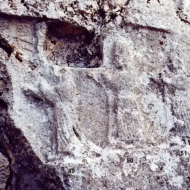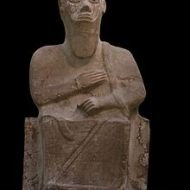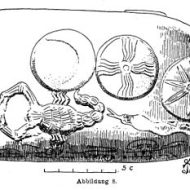Ishara : The Scorpion Goddess
Listen
At a glance
| Description | |
|---|---|
| Origin | Hittite Mythology |
| Classification | Gods |
| Family Members | N/A |
| Region | Turkey, Syria |
| Associated With | Scorpions, Sex, Passion, Love |
Introduction
Ishara, who was the tutelary goddess of Ebla, was a notable figure in the ancient city of Damascus. Although her name is not known to have come from a specific linguistic source, there were also various West Semitic and Hurrian etymologies, but they did not find sufficient support.
Her cult was able to reach other cities in the Near East, including Ebla. In addition, she was also worshipped in other cities such as Alalakh, Ugarit, and Mari. The worship of Ishara was spread to Mesopotamia through these cities. The Hurrians adopted her after they arrived in Syria, and she eventually made her way to the Hittite Pantheon.
In various areas and time periods, she was given various functions. In Ebla, she was regarded as the family’s tutelary deity, but she was also a love goddess. In Mesopotamia, she was associated with various other notable individuals such as Ishtar and Kanisurra. In the Hurrian religion, she was associated with Allani, who was regarded as the queen of the dead. She was also known as a divine guardian of oaths and a goddess of divination.
Physical Traits
There is very little information on how the goddess Ishara was represented in her physical form but some records denote warlike features due to her association with weapons. In later periods, when boundary stones were made, Ishara was represented by the scorpion instead of the bashmu. It is not clear why the change occurred, or how it was attributed to her. In Babylonian astronomy, she was also associated with a star known as the Scorpion Star.
Other Names
After initial researches, it was believed that Ishara was the main deity of the Hurrian religion. However, further studies in Ebla have revealed that other Eblaite deities such as Hebat, Adamma, and Ashtabi were also present in documents during the time of the Hurrian migrations to Syria. It is uncertain whether Shaushka or Ishtar was written in the personal names of the individuals in these documents.
During the 1980s, people were suggesting that people in Ebla should use the names of their personal characters and the sign AMA to refer to Ishara. However, this idea is no longer considered plausible.
Powers and Abilities
Ishara’s themes are creativity, passion, sexual prowess, and energy. In ancient Mesopotamia, she was regarded as a goddess of the fire and the scorpion. In Syria, she was worshipped in the form of a stinging and hot object in order to improve one’s passion or sexual prowess. In other traditions, she was also known to judge people’s affairs fairly firmly.
In addition to being a goddess, she was also known to inflict severe punishments on oath breakers. She was regarded as a deity who acted as a healer, and she was even referred to as a “Goddess of medicine.” There was a verb, isharis, that literally means to be “abounded by the illness of Ishara.” Ishara was also worshipped within the Hurrian pantheon and was associated with the underworld.
Modern Day Influence
Researchers are still trying to piece together the story behind this powerful goddess who made her presence felt across multiple civilizations and timelines. Conflicting stories, names and etymologies are the main reason behind the lack of a clear picture on the role of Ishara when compared to other deities like Ishtar or Ninkarak.
Related Images
Source
Wikipedia. “Ishara.” Link
Klengel, H. “Ishara: The Goddess of Ebla and Her Role in the Hurrian Pantheon.” Journal of Near Eastern Studies, 1980.
Pettinato, G. “The Eblaite Documents: A New Contribution to the History of the Ancient Near East.” Journal of the American Oriental Society, 1976.
Gurney, O. R., and J. G. Manning. The Hittites: An Introduction to Their History and Culture. Indiana University Press, 2004.
Frequently Asked Questions
What is Ishara the goddess of?
Išḫara is a goddess primarily associated with agriculture and fertility in ancient Near Eastern mythology. She embodies the significance of crop growth and agricultural production, reflecting the vital role of fertility in early societies. Over time, her character evolved within the Hittite pantheon, illustrating her integration into their cultural and religious practices. The worship of Išḫara highlights the agricultural dependence of these civilizations on divine favor for successful harvests. Ultimately, she represents the intersection of nature’s cycles and human agricultural endeavors.
Who was Ishara?
Ishara is a goddess from ancient Hittite mythology associated with love, fertility, and motherhood. She represents nurturing femininity and is often invoked for matters related to love, marriage, and family. Ishara is sometimes linked to the storm god Tarhun and reflects the cycles of nature, particularly agricultural fertility. Her worship included rituals and offerings aimed at securing her favor for personal and agricultural prosperity. As a deity, Ishara embodies the essential themes of love and fertility in Hittite society.
What texts mention Ishara?
Ishara is referenced in Hittite texts, particularly in religious and mythological documents. These texts often describe her attributes, roles in rituals, and connections to other deities within the Hittite pantheon.
What is Ishara's significance in Hittite mythology?
Ishara’s significance lies in her representation of love and fertility, crucial themes for Hittite society. As a nurturing goddess, she embodies the essential human experiences of relationships and family, reflecting the values of her culture.
How was Ishara worshipped in Hittite society?
Ishara was worshipped through rituals, offerings, and prayers aimed at invoking her blessings for love, marriage, and fertility. Temples dedicated to her may have hosted ceremonies to honor her and seek her favor.






